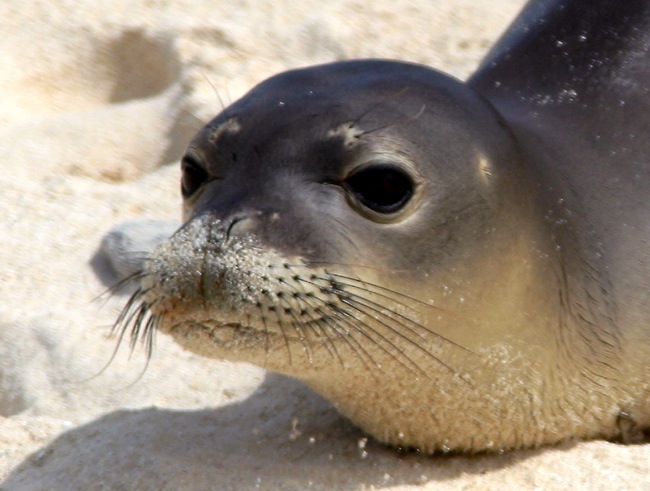Posted 12/30/2011
When the National Marine Fisheries Service proposed expanding critical habitat for the Hawaiian monk seal, teetering on the brink of extinction, it may have unwittingly set off a war against the creature. In the last two months, three seals have been found dead on Moloka`i: an adult male, a juvenile male, and a young female. A fourth has been killed on Kaua`i.
The proposed expanded critical habitat would include most shoreline areas in the Main Hawaiian Islands, from five meters above the high tide line, out to a depth of 500 meters. Excluded from the proposal are developed harbors, shores along most military facilities, and areas where the shoreline has been armored with walls or other protection from erosion.
Comments on the proposal – available for viewing on the www.regulations.gov website – show the visceral reaction to the proposal. Many of the comments suggest that fishermen believe the proposal will deny them access to fishing areas or will have the effect of reducing their catches (because of predation on fish by seals). A lot of them reflect the view that the seals are not native to these parts and are, instead, an introduced species. (The deadline for public comment expires on January 6. To add your voice, go to the “regulations” website, type “monk seal” into the search blank, and after clicking on the expanded critical habitat docket, call up the “submit a comment” link.)
Many state legislators have added their voices to those of disgruntled fishermen: they include Sens. Malama Solomon, Donovan Dela Cruz, and Ronald Kouchi and Reps. Derek Kawakami, James Tokioka, Daynette Morikawa, Jerry Chang, and Sharon Har, all signing onto letters that complain about the economic impacts of the expanded habitat. Also opposing it are Rep. Cynthia Thielen and former Gov. Linda Lingle.
The Western Pacific Fishery Management Council (Wespac) has weighed in formally, with a letter from its executive director, Kitty Simonds, claiming that there is no requirement that critical habitat be designated at all for the monk seal and, what’s more, that if NMFS wishes to designate it, it must prepare an environmental assessment or environmental impact statement beforehand. Former Wespac members, Roy Morioka (now a paid consultant to the council) and Frank Farm, have weighed in as well, strongly opposing the proposal.
Keiko Bonk, head of a non-profit group PONO, wrote in support of the proposal, noting also that “PONO is very concerned that … Wespac is spreading misinformation on monk seals throughout rural Hawai`i. It is alarming that Wespac affiliates rallied fishermen to the August 2011 critical habitat hearings throughout the state, by instilling anger towards monk seals and fear of fishery closures…. It is morally disconcerting that Wespac is confusing fishermen about the plight of the monk seals.”
William Aila, head of the Department of Land and Natural Resources, informed NMFS that the DLNR “opposes NOAA’s current proposal to designate virtually the entire state as expanded critical habitat.” He suggests instead that a “target area” approach should be taken, including known nursing and pupping sites and other areas.
The Hawaiian Monk Seal Recovery Team members (excluding those associated with Wespac and other affected agencies) support the proposal generally, but suggest that NMFS needs to do more to allay concerns from the public about the impact of expanded habitat. “While we understand that NMFS has consulted broadly while developing this proposed action, … we think that further outreach and consultation need to be conducted… A common misconception seems to be that critical habitat may impact every activity that occurs within it, when in fact many activities will not be impacted at all.”
In addition to the letters and individual comments submitted, several groups have submitted bulk comments. The group Na Moku Aupuni o Ko`olau Hui, based on Maui and active in efforts to support stream restoration in East Maui, submitted several hundred signatures on a petition opposing the proposal. The Center for Biological Diversity, which sought the expansion of critical habitat in the first place, submitted nearly 8,000 comments in favor of the proposal.



Leave a Reply